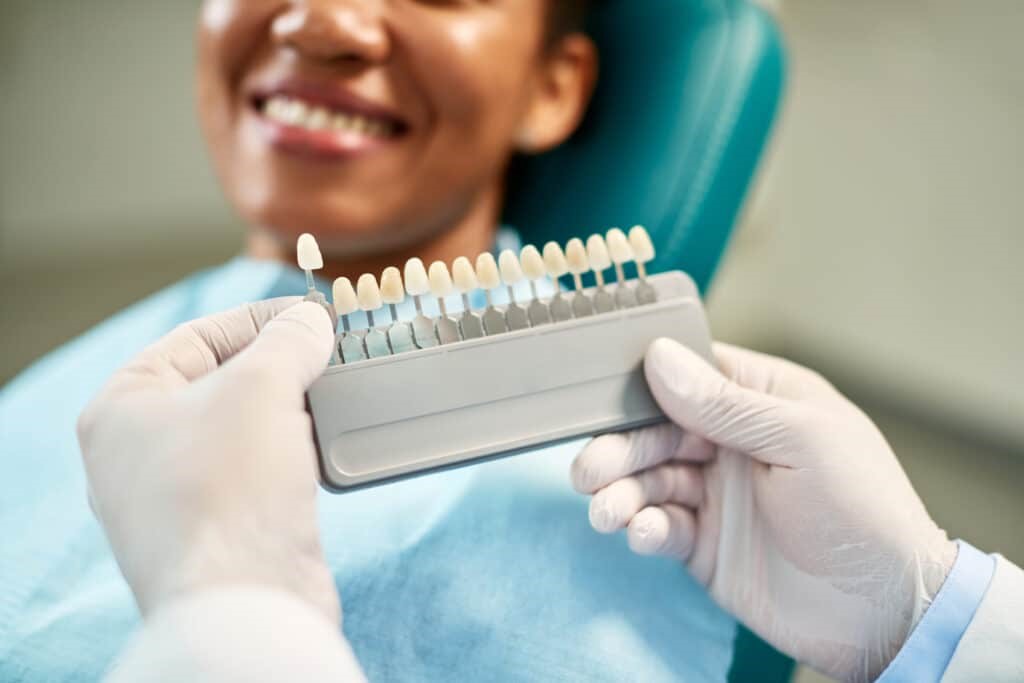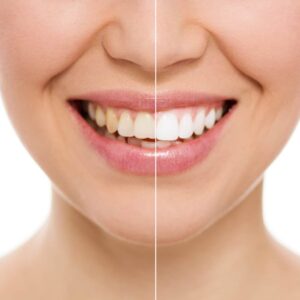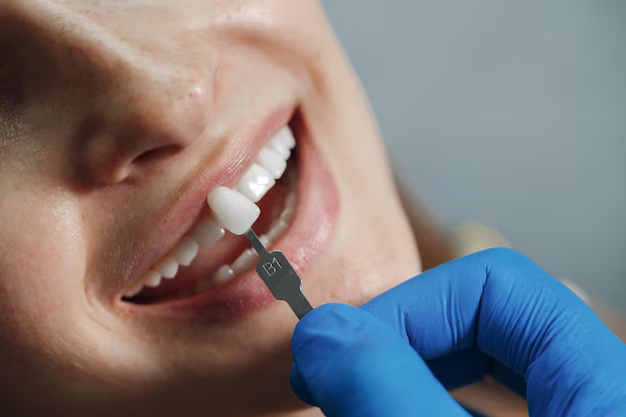In the world of cosmetic dentistry, two procedures often stand out due to their popularity and effectiveness – Invisalign and Veneers. Each of these procedures offers a unique solution to common dental issues, but determining which one is the superior choice can be challenging. This comparison between Invisalign and Veneers is intended to provide a clearer understanding of both procedures, helping you make an informed decision.
Invisalign, a clear aligner system, and veneers, a type of dental overlay, have their respective pros and cons. Therefore, the better option between Invisalign and Veneers often depends on the specific dental needs and lifestyle of the individual. This blog post aims to evaluate Invisalign and Veneers in detail, looking into their advantages and disadvantages, and providing insights into which might be a better choice for different scenarios.

What is Invisalign?
Invisalign is a modern solution to teeth straightening that is a popular alternative to traditional braces. It uses a series of clear, removable aligners, custom-made for your teeth, to gradually shift them into the desired position. Invisalign is designed to be barely noticeable in your mouth, making it a preferred choice for adults and teenagers who want to improve their smile without the noticeable metal and wires of braces.
There are several benefits to choosing Invisalign. One of the major advantages is its nearly invisible appearance. This makes it possible for users to feel more confident about their appearance during the treatment. Moreover, because the aligners are removable, they allow for easier eating, cleaning, and flossing compared to traditional braces.
However, like any other dental procedure, Invisalign also has potential drawbacks. It requires discipline as the aligners need to be worn for at least 20-22 hours per day to be effective. It might not be suitable for severe orthodontic cases where traditional braces or veneers may be more effective. The cost of Invisalign can also be a downside as it is usually more expensive than braces.
Invisalign is a powerful tool in the world of orthodontics, offering a discreet, convenient, and flexible way to create a perfect smile. When comparing Invisalign and veneers, it’s essential to consider your individual needs and consult with a dental professional to make the best choice.
What are Veneers?
Veneers are thin coverings that are placed over the front (visible) part of the tooth. They look like natural teeth and can be used to correct a wide range of dental issues, such as teeth that are stained, chipped, or have gaps. But veneers are an irreversible treatment, so having them placed is a big decision.
Before you decide to get veneers, you should understand what they involve. The process of getting veneers is more involved than with Invisalign and requires a long-term commitment, as the veneers will need to be replaced in future. They provide a quick fix for misaligned teeth and can dramatically improve the appearance of your smile. However, veneers come with a number of disadvantages. They require a significant amount of enamel removal, and the process is not reversible. Also, veneers can be more expensive than Invisalign, depending on the number of veneers you get.
Despite these drawbacks, many people find the results of veneers to be worth the costs. After all, veneers can provide a complete transformation of your smile, and can fix aesthetic issues that braces can’t fix. In the end, the decision between veneers and Invisalign should be made with the help of your dentist, taking into consideration your specific needs and circumstances.
Comparing Invisalign and Veneers: Which Is Better?
When it comes to improving your smile, both Invisalign and veneers are popular choices. However, there are key differences between the two treatments that could make one a better choice for you than the other. Here you can directly compare the two procedures in terms of cost, treatment time, effect on oral health, age suitability, visibility, longevity, and scope of issues they can fix.
| Aspect | Invisalign | Veneers |
|---|---|---|
| Cost | Generally lower cost, varies based on complexity | Typically higher cost, but can vary depending on case |
| Treatment Time | 6 to 18 months | Completed in as little as two visits over weeks |
| Effect on Oral Health | Minimal effect with proper care | Requires altering natural teeth, not reversible |
| Age Suitability | Suitable for teenagers and adults | Usually recommended for adults only |
| Visibility | Virtually invisible | More visible, but can match natural teeth color |
| Longevity | Depends on wearing retainer, can last for years | Typically lasts 10 to 15 years before replacement |
| Scope of Issues | Corrects various orthodontic issues | Addresses cosmetic issues such as discoloration, chips, misalignment, gaps |
The Cost Perspective: Invisalign vs Veneers
When it comes to cosmetic dentistry, Invisalign and veneers are two of the most popular options. The choice between Invisalign and veneers often boils down to the specific needs of the individual and, of course, the cost. Evaluating the cost perspectives of both procedures can provide a clearer picture of which option might be the better choice.
| Invisalign Cost | Veneers Cost |
|---|---|
| The average cost can range from $3,000 to $7,000. The cost of Invisalign treatment varies widely depending on the case’s complexity, the treatment duration, and the specific provider. | The cost varies widely, with porcelain veneers generally costing between $925 and $2,500 per tooth. |
The cost difference between Invisalign and veneers can be substantial, especially if multiple veneers are needed. However, it’s important to remember that cost isn’t everything. The best choice for you depends on your specific dental needs and goals. Therefore, it’s always best to have a comprehensive discussion with your dentist before making a decision.
“As a dental professional, I often get asked whether Invisalign or veneers are the better option. My answer is always: it depends on your individual needs and goals. Invisalign is a great choice for correcting alignment issues without the visibility of traditional braces, while veneers can instantly transform the aesthetic of your smile. At the end of the day, both options have their unique benefits. Your decision should align with your oral health and cosmetic goals.”
– Dr. Guneet Alag, DDS, FAGD, Fab Dental, Hayward, CA.
Real-Life Experiences: Patient Stories
When it comes to making the choice between Invisalign and veneers, real-life stories from patients who have undergone either or both procedures can provide valuable insights. These testimonials can offer a practical understanding of what to expect, helping you make an informed decision.
Story 1: The Invisalign Journey
One patient, Sarah, found herself constantly struggling with crooked teeth. After evaluating Invisalign and veneers, she chose the Invisalign route. Sarah was drawn to the convenience of being able to remove the aligners for eating and brushing. She also appreciated the gradual shift of her teeth alignment over time. “It was almost like watching a time-lapse of my teeth straightening,” she recalls. The journey wasn’t always comfortable, but Sarah is thrilled with her new smile.
Story 2: The Veneers Process
Tom, on the other hand, was looking for a quick solution for his stained and chipped teeth. He found his answer in veneers. The process involved reshaping his teeth and fitting them with custom-made veneers. “I have to admit, it was a bit uncomfortable at first. But seeing the instant transformation made it all worth it,” Tom shares. The veneers gave him a brighter and more uniform smile, boosting his confidence immensely.
Story 3: The Combined Approach
Lastly, we have Lisa who decided on a combination of both Invisalign and veneers. Lisa first used Invisalign to correct her bite and align her teeth. Once that was achieved, she opted for veneers to address her teeth’s discoloration. “I got the best of both worlds,” Lisa says. “The Invisalign treatment addressed the structural issues, and the veneers gave me that perfect finish.”
These stories demonstrate that the choice between Invisalign and veneers is deeply personal and depends on individual needs. While Sarah and Tom were happy with their respective choices, Lisa found a combination approach to be the better choice for her.
Remember, it’s essential to consult with your dentist or orthodontist before making any decision. They can help you evaluate the pros and cons of Invisalign and veneers based on your specific dental health and aesthetic goals.
Using Invisalign and Veneers Together
In the world of dental improvement, a common question that comes up is “Can I use both Invisalign and veneers together to improve my smile?”. This section will delve into the possibility and benefits of combining these two procedures for a comprehensive approach to dental enhancement.
When comparing Invisalign and veneers, it’s essential to understand their unique functionalities. While Invisalign serves as an orthodontic treatment to correct misaligned teeth, veneers are cosmetic enhancements that improve the appearance of individual teeth. This makes them an ideal pair for anyone looking to extensively upgrade their smile.
Benefits of Using Invisalign and Veneers Together
Comprehensive Dental Improvement: By using both Invisalign and veneers, you can address a wider range of dental issues, from alignment to aesthetics. This combined approach offers a comprehensive solution for total smile makeover.
Customized Treatment Plan: Both Invisalign and veneers are custom-made to fit your teeth and address your unique dental needs. This means you get a personalized treatment plan that works best for your oral health and aesthetic goals.
Improved Smile Aesthetics: Veneers can perfect the look of your teeth after Invisalign has corrected their position. This combination can lead to a more harmonious and balanced smile that boosts your confidence.
Time-Efficient: Typically, veneers can be applied soon after completing your Invisalign treatment. This means you can achieve your desired results in a relatively short period, making the combination of Invisalign and veneers a time-efficient choice.
Long-Lasting Results: Both Invisalign and veneers offer durable solutions for dental improvement. With proper care, the results can last for many years, providing you with a long-lasting, beautiful smile.
In conclusion, when evaluating Invisalign and veneers, it’s not always about choosing one over the other. In many cases, using them together can provide the best results for comprehensive dental improvement. Always consult with your dentist to determine the most suitable treatment plan for your specific needs.
Conclusion
The decision between Invisalign and veneers ultimately comes down to individual needs and preferences. Each method comes with its own set of pros and cons, and understanding these is crucial to making an informed decision.
Invisalign, for instance, offers a virtually invisible method of straightening your teeth without the discomfort often associated with traditional braces. However, it requires discipline in wearing the aligners for the recommended 20 to 22 hours per day. On the other hand, veneers can instantly provide a dramatic improvement to the appearance of your teeth, but this comes with a higher cost and the process is irreversible.
No single treatment option is superior, and the better choice between Invisalign and veneers will vary from person to person. Factors such as your lifestyle, budget, oral health, and cosmetic goals should all play a part in your decision-making process.
In conclusion, when comparing Invisalign and veneers, it’s important to consider your personal goals and circumstances. Consult with your dentist or orthodontist to discuss these options in more detail. They can help guide you on the path that is right for you, ensuring you make the best decision for your smile.
FAQs for Comparing Invisalign and Veneers: Which Is Better?
What are Invisalign and veneers?
Invisalign and veneers are both dental treatments that improve the appearance of your teeth. Invisalign is a type of clear, removable braces that gradually align your teeth over time. Veneers, on the other hand, are thin shells made from porcelain or composite resin that are bonded to the front of your teeth to improve their appearance.
What is the main difference between Invisalign and veneers?
The main difference between Invisalign and veneers is their purpose. Invisalign is primarily used to correct orthodontic issues like crooked teeth, overbites, and underbites. Veneers, however, are used to address cosmetic concerns like discoloration, chipped teeth, or gaps.
How long does each treatment take?
The duration of each treatment can vary greatly depending on the individual's dental needs. Invisalign treatment typically takes around 12 to 18 months, but it could be longer depending on the complexity of the case. Veneers usually require two visits to the dentist, the first for preparation and impression, and the second for application, typically spaced a week or two apart.
Do Invisalign and veneers hurt?
Invisalign may cause some discomfort, especially when you first start wearing the aligners or when you switch to a new set. However, this discomfort usually subsides after a few days. Veneers, on the other hand, require some enamel to be removed from your teeth, which can cause discomfort during and after the procedure. Your dentist may use local anesthesia during the procedure to minimize any discomfort.
How much do Invisalign and veneers cost?
Costs for both Invisalign and veneers can vary greatly depending on your location, the complexity of your case, and your dentist’s expertise. On average, Invisalign can cost anywhere between $3,000 to $8,000, while veneers can range from $800 to $2,000 per tooth.
Can I eat normally with Invisalign and veneers?
With Invisalign, you can remove the aligners when you eat, so there are no restrictions on what you can consume. With veneers, you should avoid eating hard or sticky foods that can potentially chip or dislodge the veneers.
Which is better, Invisalign or veneers?
Both Invisalign and veneers have their own benefits and drawbacks, and the best option for you will depend on your specific dental needs and goals. Invisalign can be a great option if you need to correct orthodontic issues, while veneers might be the right choice if you're looking to improve the appearance of your teeth. It’s best to consult with a dental professional to determine the most suitable treatment for you.
Can I get both Invisalign and veneers?
Yes, it's possible to get both Invisalign and veneers. Some people might choose to straighten their teeth with Invisalign before getting veneers. However, it's important to discuss this with your dentist to ensure the best results.
How long do the results of Invisalign and veneers last?
The results of Invisalign can last indefinitely, provided that you wear a retainer as directed by your dentist. The lifespan of veneers depends on the material used and how well they are cared for. On average, porcelain veneers can last between 10 to 15 years, while composite veneers last between 5 to 7 years.
Are there any risks or potential complications associated with Invisalign and veneers?
As with any medical procedure, both Invisalign and veneers come with potential risks and complications. Invisalign may cause temporary discomfort, and not wearing the aligners as directed could lead to less effective treatment. Veneers, on the other hand, require the removal of some tooth enamel, which is irreversible. There's also a risk that the veneers could chip or come loose. It's important to discuss these potential risks with your dentist before beginning treatment.







